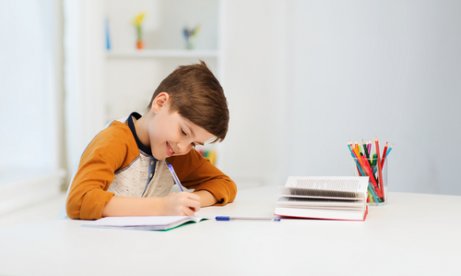Mnemonic Devices for Boosting Academic Learning

Mnemonic devices are an excellent resource for studying at any academic level. Children, youth and adults can try their hands at memorizing information and taking tests by using memory devices.
Even small children can benefit from these techniques. As parents we should guide and motivate our children to use these intellectual tools.
The complexity of these techniques can be difficult to understand. However, there are several practical exercises based on mnemonic devices that we can teach our little ones.
What are mnemonic devices?
In very broad terms, the objective of mnemonic devices is to use short phrases and images to memorize concepts. Through mental association, we can make learning simpler.
Mnemonic devices makes memorizing and remembering things easier by using techniques based on the way the human mind works. Word games and learning routines can make things easier and capture our children’s interest.
These devices are a much better resource than memorizing in a random and boring way. On top of that, parents will be pleased to realize that they can do something to make studying more fun for their little ones.
Today we’ll look at several exercises that will be useful for organizing your children’s studies.

Create fun acrostics with hidden meanings
Acrostics are simple words created from abbreviations or initials of other words. The idea is to help children learn two or more concepts by enclosing them into this keyword.
This technique can be useful, for example, to help children memorize the order of the colors of the rainbow. Kids may have a hard time learning them in order: Red, orange, yellow, green, blue, indigo, violet. But if you use the first letter of each color, they form a name: Roy G. Biv.
For children to learn the order of the colors of the rainbow, they just need to memorize this name. When they pronounce it, their minds make a simple association and they easily remember the order.
“The main purpose of mnemonic devices is the use of short phrases, images, word games, etc. to help children memorize concepts and ideas.”
Compose a song with a certain theme
This is the most commonly used technique in successful education systems like those of Finland and Estonia. The teachers in these countries use this technique to teach children from the age of 4 years old. The use of songs is one of the most effective mnemonic devices that exists.
The idea is to transmit concepts, abstractions or any type of learning through song. Instead of having to learn a boring meaning, children learn a song that’s fun and entertaining. Children end up memorizing information in an almost involuntary way.
When we were young, our teachers and parents taught us things in a similar way. One classic example is the alphabet song. Today, this technique can be useful for all types of content.
Associating the content of an image
Just like computers store their information in digits, we learn much quicker with the help of images. There’s no doubt that our senses and the use of association play a fundamental role in the human brain. This tool can be useful for very small children.
In practice, there is content that we learn through the use of images from the time we’re little. It’s the way we need to learn colors. Children also use images to learn to identify animals.
In general, these techniques consist of tricks to learn very simple concepts. However, the creation of mental and conceptual maps has a great deal to do with this resource. They allow complex processes to become much simpler.

Mnemonic devices: use technology to your favor
Why repeat something over and over again when you can record it with a digital device? Recording devices are a great learning tool for little ones.
Young university students use them a lot for their studies. But parents of middle school children aren’t so used to using this technique.
If we have young children, parents can prepare recordings to help them memorize certain concepts: it’s possible to choose and plan fun and educational content so children don’t get bored.
There are many other useful, complex and fun techniques out there. Almost all types of knowledge can be memorized through these tools. The trick is to adapt them to our own mind and to our children’s minds.
Mnemonic devices are an excellent resource for studying at any academic level. Children, youth and adults can try their hands at memorizing information and taking tests by using memory devices.
Even small children can benefit from these techniques. As parents we should guide and motivate our children to use these intellectual tools.
The complexity of these techniques can be difficult to understand. However, there are several practical exercises based on mnemonic devices that we can teach our little ones.
What are mnemonic devices?
In very broad terms, the objective of mnemonic devices is to use short phrases and images to memorize concepts. Through mental association, we can make learning simpler.
Mnemonic devices makes memorizing and remembering things easier by using techniques based on the way the human mind works. Word games and learning routines can make things easier and capture our children’s interest.
These devices are a much better resource than memorizing in a random and boring way. On top of that, parents will be pleased to realize that they can do something to make studying more fun for their little ones.
Today we’ll look at several exercises that will be useful for organizing your children’s studies.

Create fun acrostics with hidden meanings
Acrostics are simple words created from abbreviations or initials of other words. The idea is to help children learn two or more concepts by enclosing them into this keyword.
This technique can be useful, for example, to help children memorize the order of the colors of the rainbow. Kids may have a hard time learning them in order: Red, orange, yellow, green, blue, indigo, violet. But if you use the first letter of each color, they form a name: Roy G. Biv.
For children to learn the order of the colors of the rainbow, they just need to memorize this name. When they pronounce it, their minds make a simple association and they easily remember the order.
“The main purpose of mnemonic devices is the use of short phrases, images, word games, etc. to help children memorize concepts and ideas.”
Compose a song with a certain theme
This is the most commonly used technique in successful education systems like those of Finland and Estonia. The teachers in these countries use this technique to teach children from the age of 4 years old. The use of songs is one of the most effective mnemonic devices that exists.
The idea is to transmit concepts, abstractions or any type of learning through song. Instead of having to learn a boring meaning, children learn a song that’s fun and entertaining. Children end up memorizing information in an almost involuntary way.
When we were young, our teachers and parents taught us things in a similar way. One classic example is the alphabet song. Today, this technique can be useful for all types of content.
Associating the content of an image
Just like computers store their information in digits, we learn much quicker with the help of images. There’s no doubt that our senses and the use of association play a fundamental role in the human brain. This tool can be useful for very small children.
In practice, there is content that we learn through the use of images from the time we’re little. It’s the way we need to learn colors. Children also use images to learn to identify animals.
In general, these techniques consist of tricks to learn very simple concepts. However, the creation of mental and conceptual maps has a great deal to do with this resource. They allow complex processes to become much simpler.

Mnemonic devices: use technology to your favor
Why repeat something over and over again when you can record it with a digital device? Recording devices are a great learning tool for little ones.
Young university students use them a lot for their studies. But parents of middle school children aren’t so used to using this technique.
If we have young children, parents can prepare recordings to help them memorize certain concepts: it’s possible to choose and plan fun and educational content so children don’t get bored.
There are many other useful, complex and fun techniques out there. Almost all types of knowledge can be memorized through these tools. The trick is to adapt them to our own mind and to our children’s minds.
All cited sources were thoroughly reviewed by our team to ensure their quality, reliability, currency, and validity. The bibliography of this article was considered reliable and of academic or scientific accuracy.
- Culcay Peláez, M. B., & Cardoso Landívar, M. E. (2017). Guía metodológica de técnicas de estudio para el autoaprendizaje en niños de sexto y séptimo de Educación Básica en la Unidad Educativa José Víctor Ordoñez (Bachelor’s thesis, Universidad del Azuay). http://dspace.uazuay.edu.ec/handle/datos/7024
- Muñoz Muñoz, Y. E., & Troya Baquerizo, M. P. (2017). Plan de talleres sobre las Técnicas de Estudio como una de las bases para el Aprendizaje Significativo en niños y niñas de 6º Grado de Educación General (Bachelor’s thesis, Universidad de Guayaquil Facultad de Ciencias Psicológicas). http://repositorio.ug.edu.ec/handle/redug/25817
- Cuellar, J. A. M. (2013). Recursos multimedia y mnemotecnia para la adquisición de vocabulario en inglés. Revista Virtual Universidad Católica del Norte, 1(38), 112-126. https://revistavirtual.ucn.edu.co/index.php/RevistaUCN/article/view/408
This text is provided for informational purposes only and does not replace consultation with a professional. If in doubt, consult your specialist.








